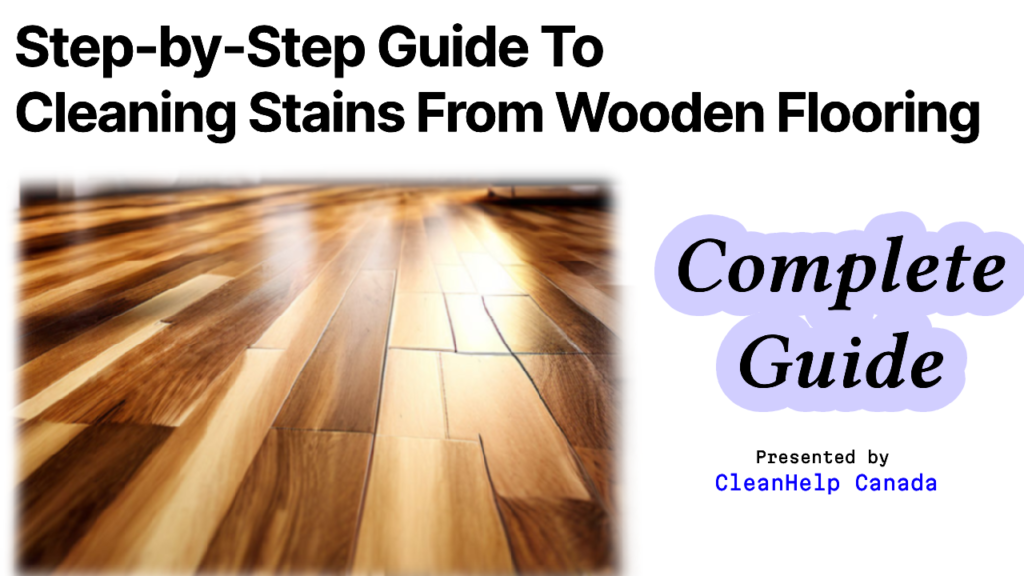Wooden floors add elegance and warmth to any home, but they can also be prone to stains and spills. Cleaning and maintaining these beautiful surfaces is essential to keep them looking their best. In this comprehensive guide, we’ll explore effective methods to clean stains from wooden floors, focusing on practical steps, natural solutions, and professional services.
Understanding Wooden Floors and Stains
Types of Wooden Floors

Wooden floors come in various types, including:
- Solid Hardwood: Made from a single piece of wood, offering durability and a timeless look.
- Engineered Hardwood: Composed of multiple layers, providing stability and resistance to moisture.
- Laminate Wood: A budget-friendly option that mimics the appearance of real wood.
Each type requires specific care and cleaning methods to ensure longevity and aesthetic appeal.
Common Stains and Causes
Wooden floors can encounter various stains, including:
- Water Stains: Caused by spills, leaks, or excessive humidity. It is not so difficult to remove hard-water stains.
- Food and Drink Stains: Resulting from spills of coffee, wine, juices, and other foods.
- Pet Stains: Including urine, vomit, and muddy paw prints.
- Ink and Dye Stains: From markers, pens, and hair dye.
- Scuff Marks and Scratches: Caused by furniture, shoes, and everyday use.
Understanding the cause of the stain is crucial for selecting the right cleaning method.
Preparation for Cleaning
Gathering Necessary Supplies
Before starting the cleaning process, gather the following supplies:
- Soft cloths or microfiber cloths
- Warm water
- White vinegar
- Baking soda
- Hydrogen peroxide
- Olive oil
- Dish soap
- Toothpaste (non-gel)
- Sandpaper (fine grit)
- Wood polish or wax
- Protective gloves
Safety Precautions
- Always test cleaning solutions on a small, inconspicuous area first.
- Use protective gloves to avoid skin irritation.
- Ensure proper ventilation when using chemical cleaners.
Step-by-Step Cleaning Methods
I. Removing Water Stains
Method 1: Using Baking Soda and Water
- Mix a Paste: Combine baking soda with water to form a paste.
- Apply the Paste: Gently rub the paste onto the water stain using a soft cloth.
- Wipe Clean: Use a damp cloth to remove the paste.
- Dry the Area: Dry the area thoroughly with a clean cloth.
Method 2: Using Toothpaste
- Apply Toothpaste: Dab a small amount of non-gel toothpaste on the stain.
- Rub Gently: Use a soft cloth to rub the toothpaste into the stain.
- Wipe Clean: Remove the toothpaste with a damp cloth.
- Dry the Area: Ensure the area is completely dry.
II. Removing Food and Drink Stains
Method 1: Using White Vinegar and Water
- Mix a Solution: Combine equal parts white vinegar and warm water.
- Apply the Solution: Dampen a cloth with the solution and blot the stain.
- Wipe Clean: Use a clean, damp cloth to wipe away the vinegar solution.
- Dry the Area: Dry the area with a soft cloth.
Method 2: Using Hydrogen Peroxide
- Dampen a Cloth: Soak a cloth in hydrogen peroxide.
- Apply to the Stain: Place the cloth on the stain and let it sit for a few minutes.
- Wipe Clean: Remove the cloth and wipe the area with a damp cloth.
- Dry the Area: Dry thoroughly with a clean cloth.
III. Removing Pet Stains
Method 1: Using Dish Soap and Water
- Mix a Solution: Combine a few drops of dish soap with warm water.
- Blot the Stain: Use a cloth to blot the stain with the soapy water.
- Rinse and Wipe Clean: Rinse the cloth with clean water and wipe the area.
- Dry the Area: Dry thoroughly with a clean cloth.
Method 2: Using Baking Soda and Vinegar
- Sprinkle Baking Soda: Cover the stain with baking soda and let it sit for a few hours.
- Vacuum the Area: Vacuum up the baking soda.
- Apply Vinegar Solution: Dampen a cloth with equal parts vinegar and water, and blot the stain.
- Wipe Clean and Dry: Wipe with a damp cloth and dry thoroughly.
IV. Removing Ink and Dye Stains
Method 1: Using Rubbing Alcohol
- Dampen a Cloth: Soak a cloth in rubbing alcohol.
- Blot the Stain: Gently blot the stain, being careful not to spread it.
- Wipe Clean: Use a damp cloth to wipe the area.
- Dry the Area: Dry thoroughly with a clean cloth.
Method 2: Using Hydrogen Peroxide
- Apply Hydrogen Peroxide: Soak a cloth in hydrogen peroxide and place it on the stain.
- Let It Sit: Allow it to sit for a few minutes.
- Wipe Clean and Dry: Wipe the area with a damp cloth and dry thoroughly.
NOTE: You can use Hydrogen Peroxide for other purposes, such as cleaning the kitchen sink, removing mould from the bathroom, shining the bathtub surface, cleaning the toilet, and many more.
V. Removing Scuff Marks and Scratches
Method 1: Using Olive Oil and Vinegar
- Mix a Solution: Combine equal parts olive oil and white vinegar.
- Apply to the Area: Use a cloth to apply the solution to the scuff marks or scratches.
- Buff the Area: Buff the area gently with a soft cloth.
- Wipe Clean and Dry: Wipe with a damp cloth and dry thoroughly.
Method 2: Using Sandpaper and Wood Polish
- Sand the Area: Lightly sand the scratch with a fine-grit sandpaper.
- Apply Wood Polish: Apply wood polish to the sanded area.
- Buff and Shine: Buff the area with a soft cloth to restore shine.
Preventative Measures
I. Regular Cleaning and Maintenance
- Sweep and Vacuum: Regularly sweep or vacuum to remove dirt and debris.
- Mop with Care: Use a damp mop with a wood-friendly cleaner for deeper cleaning.
- Wipe Spills Immediately: Quickly wipe up spills to prevent stains and water damage.
Protective Measures
- Use Rugs and Mats: Place rugs or mats in high-traffic areas and near entryways.
- Furniture Pads: Use pads on furniture legs to prevent scratches and scuff marks.
- Control Humidity: Maintain indoor humidity levels to prevent wood expansion and contraction.
When to Call Professionals
Benefits of Professional Cleaning Services
- Expertise and Experience: Professional cleaners have the knowledge and experience to handle all types of stains and floors.
- High-Quality Products: Access to commercial-grade cleaning products that are effective and safe for wooden floors.
- Time-Saving: Save time and effort by entrusting the cleaning to professionals.
CleanHelp Canada: Your Best Cleaning Partner
CleanHelp Canada is dedicated to providing top-notch cleaning services to residents across the country. Our team of professionals is skilled in handling various types of wooden floors and stains, ensuring your home remains pristine and inviting. Whether you need regular cleaning, deep cleaning, or stain removal, CleanHelp Canada is here to help.
Conclusion
Maintaining the beauty of your wooden floors requires regular care and the right cleaning techniques. By following the methods outlined in this guide, you can effectively remove stains and keep your floors looking their best. For residents in Canada, CleanHelp Canada offers unparalleled cleaning services to ensure your home remains spotless and welcoming. Trust us as your best cleaning partner to handle all your cleaning needs with professionalism and care.
